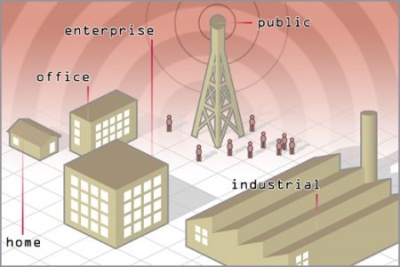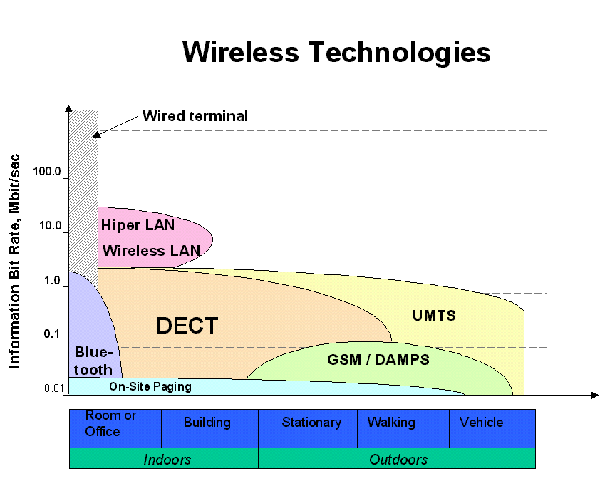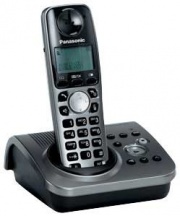Digital Enhanced Cordless Telecommunications (DECT)
From Computing and Software Wiki
DECT or Digital Enhanced Cordless Telecommunications is a radio standard for short-range cordless communications. It is commonly used for domestic or corporate purposes. It is suited to voice, data and networking applications with a range of up to 500 metres.
DECT was developed by the European Telecommunications Standards Institute (ETSI); an independent, non-profit, standardization organization in the telecommunications industry in Europe. Although DECT was developed by ETSI it has since been adopted by many countries all over the world.
While the original DECT frequency band is 1880 MHz - 1900 MHz, the frequency allocation has changed in some countries like the United States so that DECT devices can be sold there. Since these channels are reserved exclusively for voice communication applications, they are much less likely to experience interference from other wireless devices such as wireless networks or baby monitors. DECT devices are therefore known as being interference free.
Contents |
Applications

DECT has numerous applications and services. The range of DECT applications are listed below:
- Residential
- Public Switched Telephone Network (PSTN) access
- Integrated Services Digital Network (ISDN) access
- Wireless Private Branch Exchange (PABX)
- Global System for Mobile communications (GSM) access
- Wireless Local Loop
- Cordless Terminal Mobility (CTM)
- Local Area Network access supporting voice telephony, fax, modem, E-mail, Internet, X.25 and many other services
The DECT standard originally envisaged three major areas of application:[1]
- domestic cordless telephony, using a single base station to connect one or more handsets to the public telecoms network, which is now available
- enterprise premises cordless PABXs and wireless LANs, using many base stations for coverage. Calls continue as users move between different coverage cells, through a mechanism called handover. Traffic both within the system and to the public telecoms network
- public access, using large numbers of base stations to provide building or urban area coverage as part of a public telecoms network.
The domestic application, or cordless home telephones, has been very successful. The enterprise PABX market has had some success, but the public access application has not succeeded, since public cellular networks have fulfilled the need better.
DECT Features
The DECT standard allows for the proficient use of the radio spectrum through several advanced digital radio techniques. Delivering low risk of radio interference and low power technology, the DECT standard still ensures high speech quality and security. DECT Features include:
- TDMA (Time Division Multiple Access) radio access – low radio interference and high system capacity; is capable of handling up to 100'000 users per km² floor space in an office.
- ADPCM (Adaptive Differential Pulse Code Modulation) speech encoding – ensures that DECT phones have very high speech quality, which is similar to wireline telephony
- DCS/DCA (Dynamic Channel Selection / Allocation) is a unique DECT capability that guarantees that the best radio channels available are used; For example, this happens when a cordless phone is in standby mode as well as throughout the call; this feature also ensures that DECT telephony can coexist with other DECT applications, and with other systems in the same frequency, with high-quality, robust and secure communications for end-users
- Some other features - Encryption for maximum call security and optimized radio transmission for maximum battery life.
DECT basic technology and the various profiles enhance the DECT standard, introducing evolutionary applications and services. The GAP profile, for example, ensures interoperability of equipment from different providers for voice applications.
Technical Details

DECT Technologies
DECT 6.0
DECT Data Networks
VoIP/IP-DECT
The New Generation of DECT
Due to its ability to integrate multimedia applications – such as voice, data, internet services and multi-operator services, DECT is in prime position to be utilized in the newest technologies. The newest features available include the following:
- Video telephony capability
- Plug & Play functionality of all components
- Automatic device detection and configuration.
- Superior voice quality better than any existing (Wideband Speech)
- Support of Broadband Data and Audio Streaming
- Streaming CD Quality Audio Content
- Home Monitoring, Door phone, Baby monitor, Mailbox
These new specifications first became available in March 2007, following the publication of an Overview Report. Themes of other publications related to New Generation DECT include Wideband speech, Extended Wideband speech services and IP Packet data.
References
- Prof. Dr. W. Kowalk (2007-03-13). Rechnernetze – DECT Retrieved on 2009-04-09. An introduction to DECT.
See also
External Links
--Colbyl2 17:32, 8 April 2009 (EDT)

